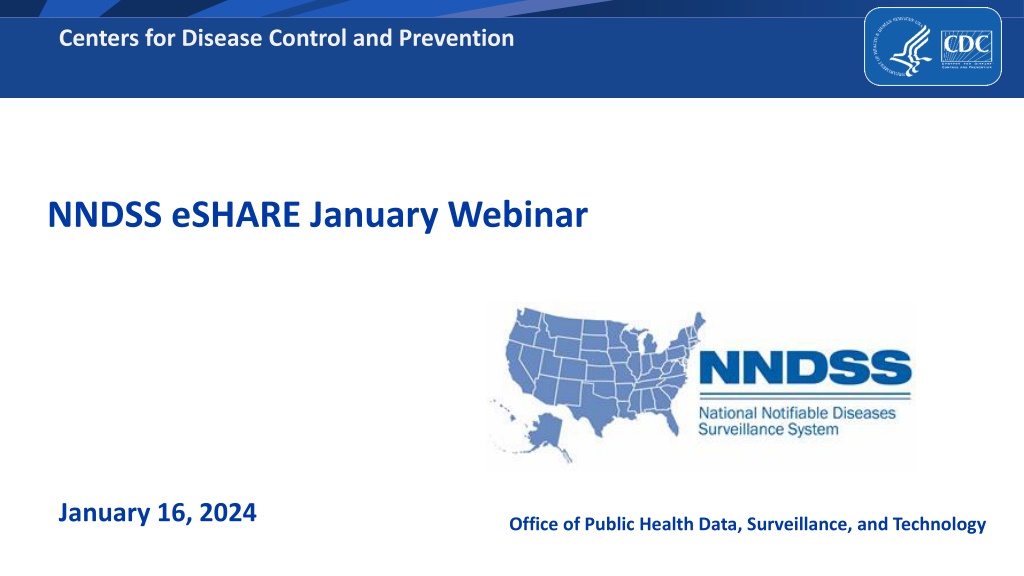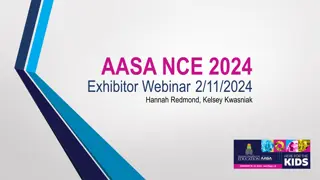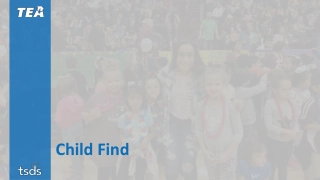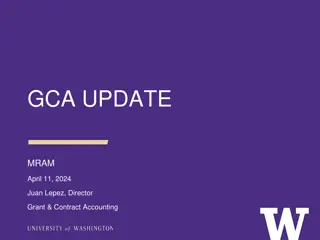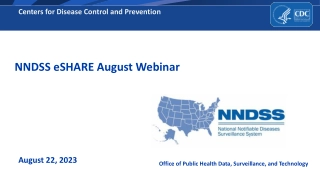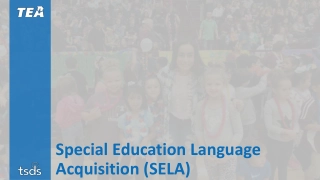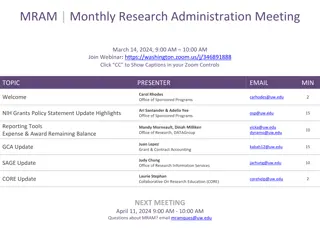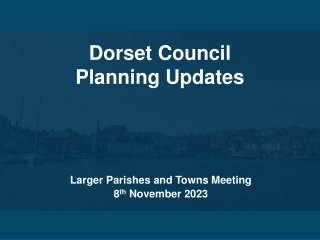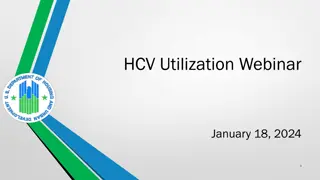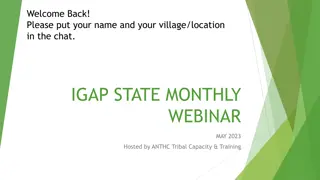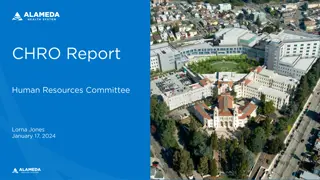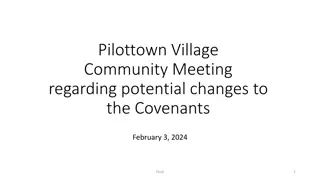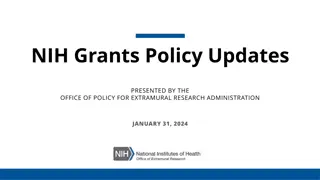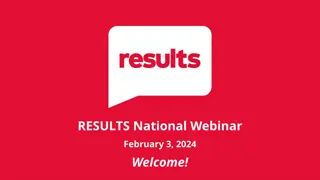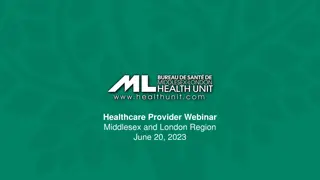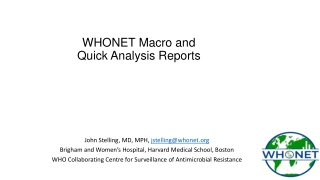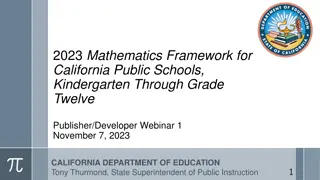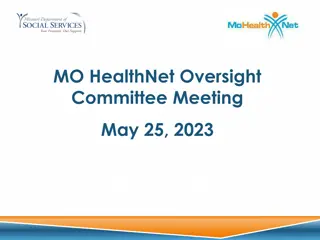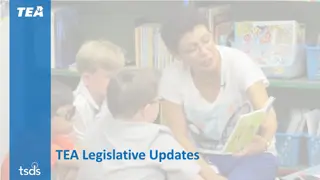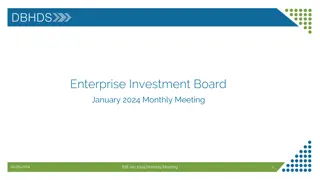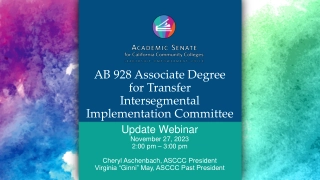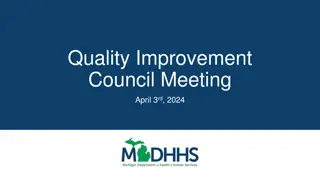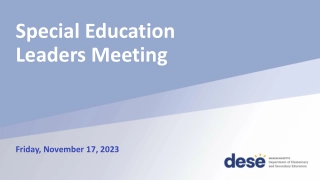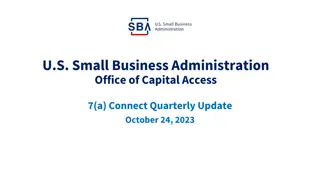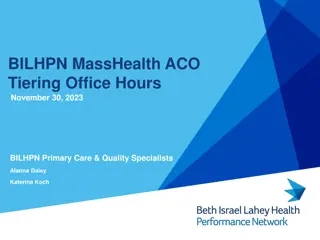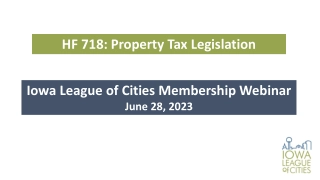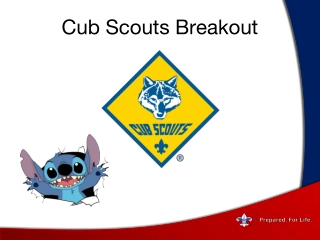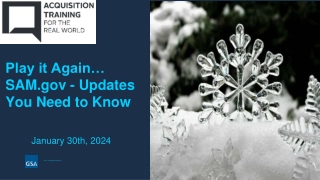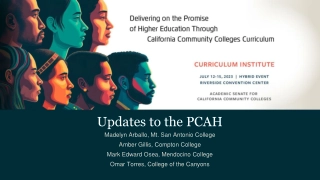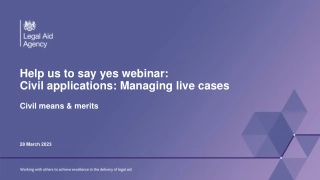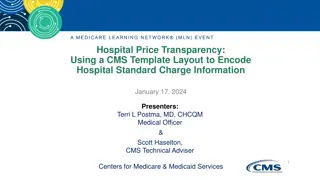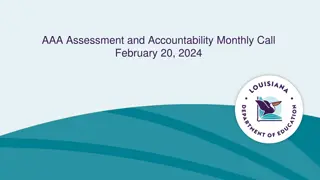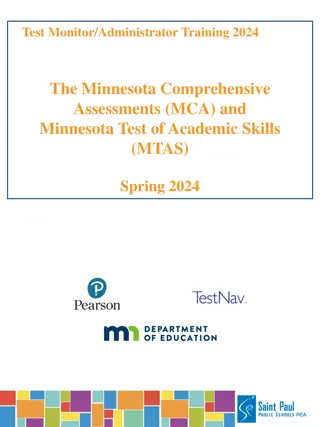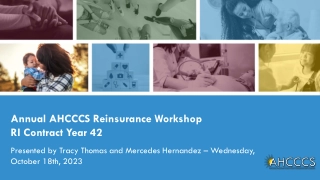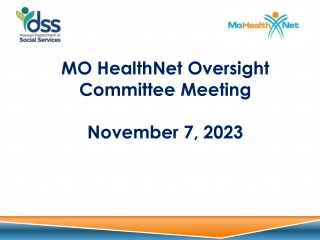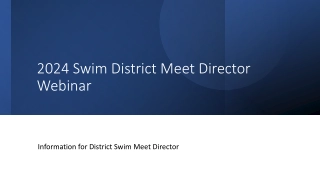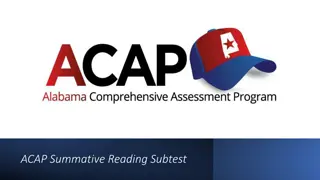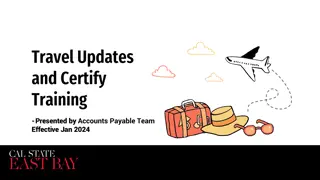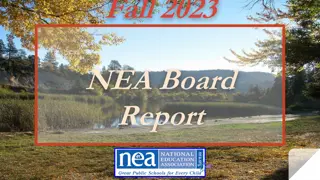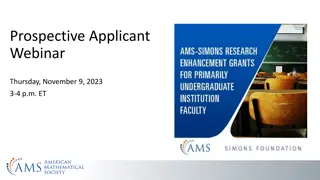NNDSS Updates and Changes for 2024 Webinar Highlights
The Centers for Disease Control and Prevention (CDC) shared important updates and announcements during the NNDSS eSHARE January Webinar in 2024. Topics included changes based on CSTE position statements, new NNDSS diseases, conditions, event codes, and more. The webinar covered the Total Message Mapping Guide (MMG) in production, 2024 NNDSS changes, and new nationally notifiable conditions. Various experts presented on the updates and what jurisdictions need to know for the upcoming year.
NNDSS Updates and Changes for 2024 Webinar Highlights
PowerPoint presentation about 'NNDSS Updates and Changes for 2024 Webinar Highlights'. This presentation describes the topic on The Centers for Disease Control and Prevention (CDC) shared important updates and announcements during the NNDSS eSHARE January Webinar in 2024. Topics included changes based on CSTE position statements, new NNDSS diseases, conditions, event codes, and more. The webinar covered the Total Message Mapping Guide (MMG) in production, 2024 NNDSS changes, and new nationally notifiable conditions. Various experts presented on the updates and what jurisdictions need to know for the upcoming year.. Download this presentation absolutely free.
Presentation Transcript
Centers for Disease Control and Prevention NNDSS eSHARE January Webinar January 16, 2024 Office of Public Health Data, Surveillance, and Technology
Agenda NNDSS Updates and Announcements What Jurisdictions Need to Know for 2024 Questions and Answers
NNDSS Updates and Announcements Hang Nguyen, MS Office of Public Health Data, Surveillance, and Technology
Title Text here 4
Total Message Mapping Guide (MMG) in Production 2023 Status as of 1/17/2023 5
Total Message Mapping Guide (MMG) in Production 2024 Status as of 1/16/2024 6
2024 Changes to NNDSS What Jurisdictions Need to Know Sara Johnston, MPH Office of Public Health Data, Surveillance, and Technology
Topics Changes based on CSTE position statements New NNDSS diseases and conditions Conditions with revised surveillance case definitions No event code changes New or retired event codes Other position statement update Event code reminder: CP-CRE CSTE case surveillance data standardization efforts Annual NNDSS data reconciliation process 8
Changes to NNDSS based on approved Council of State and Territorial Epidemiologists (CSTE) position statements 9
New NNDSS Conditions* - MMWR Year 2024 Disease/Condition Nationally Notifiable? Event Code Cronobacter, invasive infection among infants Yes 13060 Congenital cytomegalovirus infection No 13050 Congenital cytomegalovirus disease No 13051 Toxoplasmosis No 13070 Congenital toxoplasmosis No 13071 Toxoplasmosis, active primary infection No 13072 Toxoplasmosis, reactivation disease No 13073 Toxoplasmosis, past infection/unable to classify No 13074 *CDC is seeking Office of Management and Budget Paperwork Reduction Act (OMB PRA) approval to receive case notifications for these conditions. Morbidity and Mortality Weekly Report refer to MMWR Weeks Calendar. 10
Invasive Cronobacter infection among infants Event code 13060 Case definition CSTE PS 23-ID-03 Establishes new nationally notifiable condition Confirmed, probable, suspect Notification timeframe: immediately notifiable, urgent (within 24 hours) Submission options HL7 Generic Case Notification version 2 message mapping guide (GenV2 MMG) (preferred) Alternates: GenV1, NEDSS Base System (NBS) master message, NETSS file Additional data: System for Enteric Disease Response, Investigation, and Coordination (SEDRIC) NNDSS publication case classification Weekly and annual tables Confirmed, probable Low incidence verification 11
Have a Cronobacter reporting exception? Contact CDC! If you have not already alerted CDC, email edx@cdc.gov if: Cronobacter is not reportable due to state law or regulation Data on Cronobacter are unable to be sent to CDC or are unavailable 12
Congenital cytomegalovirus (cCMV) Event codes 13050 Congenital cytomegalovirus infection 13051 Congenital cytomegalovirus disease Case definition CSTE PS 23-ID-02 Establishes new condition under standardized surveillance Confirmed, probable Submission options HL7 GenV2 MMG (preferred) Alternates: GenV1, NBS master message, NETSS file NNDSS publication case classification Not published; NNDSS does not publish conditions under standardized surveillance 13
Toxoplasmosis Event codes 13070 Toxoplasmosis confirmed, probable 13071 Congenital toxoplasmosis confirmed, probable 13072 Toxoplasmosis, active primary infection confirmed, probable 13073 Toxoplasmosis, reactivation disease confirmed, probable 13074 Toxoplasmosis, past infection/unable to classify confirmed 12020 Toxoplasmosis *Retired Case definition CSTE PS 23-ID-08 Establishes new condition under standardized surveillance Submission options HL7 GenV2 MMG (preferred) Alternates: GenV1, NBS master message, NETSS file NNDSS publication case classification Not published; NNDSS does not publish conditions under standardized surveillance 14
Two ways to report non-congenital toxoplasmosis 1) Toxoplasmosis 13070 For health departments that don t have the capacity to further classify OR 2) Use one of three subtypes: active primary infection (13072); active reactivation disease (13073); or past infection or unable to classify (13074) For health departments with the capacity and resources to conduct additional surveillance 15
Revised Case Definitions - MMWR Year 2024 No changes to event codes Disease/Condition Nationally Notifiable? Event Code Hepatitis B, acute Yes 10100 Hepatitis B, chronic Yes 10105 Mumps Yes 10180 Poliomyelitis, paralytic Yes 10410 Varicella (chickenpox) Yes 10030 16
Changes or updates indicated by bold Hepatitis B Event code Case definition CSTE PS 23-ID-05 Aggregates acute and chronic position statements into a single document Clarifies distinction from perinatal hepatitis B cases Improves sensitivity and specificity of acute hepatitis B case classifications and ability to confirm chronic cases Modifies probable case classification for chronic hepatitis B Creates probable case classification for acute hepatitis B Notification timeframe: routine Submission options: HL7 Hepatitis MMG (preferred) Alternates: NBS master message, NETSS file NNDSS publication case classification Weekly and annual tables (new for chronic) Confirmed, probable 10100 Hepatitis B, acute confirmed, probable 10105 Hepatitis B, chronic confirmed, probable 17
Changes or updates indicated by bold Mumps Event code 10180 Case definition CSTE PS 23-ID-06 Updates clinical, laboratory, and epidemiologic linkage criteria Removes requirement of symptoms from confirmed case classification Notification timeframe: routine Submission options HL7 Mumps MMG (preferred) Alternates: NBS master message, NETSS file NNDSS publication case classification Weekly and annual tables Confirmed, probable (update: removes unknown) 18
Changes or updates indicated by bold Poliomyelitis, paralytic Event code 10410 Case definition CSTE PS 23-ID-07 Adds laboratory component for confirmed classification Removes probable classification Notification timeframe: immediately notifiable, urgent (24 hours) Submission options: HL7 GenV2 MMG (preferred) Alternates: GenV1, NBS master message, NETSS file NNDSS publication case classification Weekly and annual tables Confirmed 19
Changes or updates indicated by bold Varicella (chickenpox) Event code 10030 Case definition CSTE PS 23-ID-09 Updates clinical, laboratory, and epidemiologic linkage criteria Updates healthcare record criteria for case reporting Notification timeframe: routine Submission options HL7 Varicella version 2 MMG (preferred) Alternates: HL7 Varicella v1 MMG, NBS master message, NETSS file NNDSS publication case classification Weekly and annual tables Confirmed, probable 20
Revised Case Definitions - MMWR Year 2024 Changes to event codes (1 of 2) Disease/Condition Nationally Notifiable? Event Code Anaplasmosis Yes 11090 Ehrlichia chaffeensis infection Yes 11088 Ehrlichia ewingii infection Yes 11089 Ehrlichia muris eauclairensis infection* Yes 11092 Ehrlichia infection, other spp. or unspeciated* Yes 11093 Ehrlichiosis/anaplasmosis, undetermined Retired 11091 *CDC is seeking Office of Management and Budget Paperwork Reduction Act (OMB PRA) approval to receive case notifications for these conditions. 21
Changes or updates indicated by bold Anaplasmosis Event code 11090 11091 Ehrlichiosis/anaplasmosis, undetermined *Retired Case definition CSTE PS 23-ID-01 Now distinct from ehrlichiosis Updates laboratory and clinical evidence Notification timeframe: routine Submission options: HL7 Lyme and Tickborne Rickettsial Diseases MMG (preferred) Alternates: HL7 GenV2 with case report form, GenV1, NBS master message, NETSS NNDSS publication case classification Annual tables (no longer in weekly) Confirmed, probable 22
Changes or updates indicated by bold Ehrlichiosis Event codes Case definition CSTE PS 23-ID-04 Now distinct from anaplasmosis Updates laboratory and clinical evidence Only report at species level if molecular testing is performed Confirmed, probable, suspect Notification timeframe: routine Submission options: HL7 Lyme and Tickborne Rickettsial Diseases MMG (preferred) Alternates: HL7 GenV2 with case report form, GenV1, NBS master message, NETSS NNDSS publication case classification Annual tables (no longer in weekly) Confirmed, probable 11088 Ehrlichia chaffeensis infection confirmed 11089 Ehrlichia ewingii infection confirmed 11092 Ehrlichia muris eauclairensis infection confirmed *New 11093 Ehrlichia infection, other spp. or unspeciated confirmed or probable *New 11091 Ehrlichiosis/anaplasmosis, undetermined *Retired 23
Revised Case Definitions - MMWR Year 2024 Changes to event codes (2 of 2) Disease/Condition Nationally Notifiable? Event Code Zika virus disease, non-congenital Yes 50223 Zika virus disease, congenital Yes 50224 Zika virus infection, non-congenital No, retired 50221 Zika virus infection, congenital No, retired 50222 24
Changes or updates indicated by bold Zika virus Event code Case definition CSTE PS 23-ID-10 Updates laboratory, clinical, and epidemiologic linkage criteria Removes Zika virus infection from nationally notifiable conditions list Confirmed, probable Notification timeframe: routine Submission options: HL7 Arboviral MMG Alternate: ArboNET NNDSS publication case classification Non-congenital: weekly and annual tables Congenital: annual only 50223 Zika virus disease, non-congenital 50224 Zika virus disease, congenital 50221 Zika virus infection, non-congenital *Retired 50222 Zika virus infection, congenital *Retired 25
Neonatal abstinence syndrome (NAS) Event code: None Case definition 23-MCH-01 Condition under standardized surveillance Updated for clarity in interpretation, consistency in reporting across jurisdictions, and to address concerns identified during implementation CDC is not routinely requesting case data (not nationally notifiable) Jurisdictions funded to report data should report cases to the CDC Division of Birth Defects and Infant Disorders (DBDID) NNDSS tables will not include NAS cases 27
Event code reminder: carbapenemase-producing carbapenem-resistant Enterobacteriaceae (CP-CRE) retiring 28
Carbapenemase-Producing Organism (CPO) Implementation Plans, for 2023 and 2024 MMWR Year 2023: transition year NNDSS weekly tables will publish confirmed cases as CPO, total for: Carbapenemase-producing carbapenem-resistant Enterobacteriaceae (CP-CRE) (event code 50244) CPO, clinical (event code 50270) CPO, screening (event code 50271) MMWR Year 2024: CP-CRE event code (50244) retired CP-CRE case notifications will error out MMWR Year 2024: full implementation year for CPO Confirmed cases for CPO clinical (50270), CPO screening (50271), and CPO total displayed in NNDSS weekly tables 29
Resources NNDSS website: https://ndc.services.cdc.gov/event-codes-other-surveillance-resources/ 2024 Resources NNDSS Event Code List PHIN VADS Value Set for Event Code List MMWR Weeks Calendar Notification Requirements Letter to State and Territorial Epidemiologists Reporting Exceptions for National Notifiable Diseases NNDSS Case Definitions: https://ndc.services.cdc.gov/ 2024 updates to be posted soon CSTE Position Statement Archive: www.cste.org/general/custom.asp?page=PositionStatements Direct links included throughout this presentation 30
Hospitalization Travel history Pregnancy Industry and occupation Sexual orientation and gender identity Immunization history Exposure/risk/underlying conditions Death Signs/symptoms/clinical manifestations Identifiers (case/event-related/laboratory) Laboratory Medication/treatment Race/ethnicity/tribal affiliation Reporting source Disability Additional social determinants of health CSTE/CDC case surveillance data standardization efforts 32
Be part of the future of case notification Sign-up for a Data Element Specific Team, using the Smartsheet link. Contact Becky Lampkins (CSTE) at blampkins@cste.org with any questions. 33
CDC will continue to use the new and improved portal for data reconciliation Review and approval within Message Validation, Processing, and Provisioning System (MVPS) portal CDC continuing to gather feedback and make improvements Any substantive changes will be in collaboration with jurisdictions and CDC programs Continue to use tools within MVPS throughout the year Monitor messages Correct discrepancies 35
Thank you! Next NNDSS eSHARE: February 20, 2024 Subscribe to Case Surveillance News Access NNDSS Technical Resource Center Email edx@cdc.gov for technical help Learn about case surveillance modernization For more information, contact CDC 1-800-CDC-INFO (232-4636) TTY: 1-888-232-6348 www.cdc.gov The findings and conclusions in this report are those of the authors and do not necessarily represent the official position of the Centers for Disease Control and Prevention.
